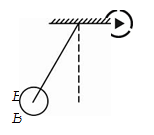Which of the following examples represent periodic motion?
(a) A swimmer completing one return trip from one bank of a river to other bank. (b) A freely suspended bar magnet displaced from its N−S direction and released. (c) A hydrogen molecule rotating about its centre of mass. (d) An arrow released from a bow.
To determine which of the given examples represent periodic motion, we first need to understand what periodic motion is. Periodic motion is defined as the motion of an object that repeats itself at regular intervals of time. In simpler terms, if an object moves from a starting position to a certain point and then returns to its starting position, and this process can be repeated indefinitely in a consistent time frame, it is considered periodic motion.
Now, let's analyze each example one by one:
Step 1: Analyze Example (a)
Example (a): A swimmer completing one return trip from one bank of a river to the other bank.
- The swimmer moves from one bank to the other and then returns. However, this motion does not repeat indefinitely in a fixed time period. The swimmer may take different amounts of time for each trip based on various factors (like fatigue, speed, etc.).
- Conclusion: This is not periodic motion.
Step 2: Analyze Example (b)
Example (b): A freely suspended bar magnet displaced from its N-S direction and released.
- When the bar magnet is displaced and released, it will oscillate back and forth around its equilibrium position (the N-S direction). This motion will continue indefinitely with a fixed time period due to the restoring force acting on the magnet.
- Conclusion: This is periodic motion.
Step 3: Analyze Example (c)
Example (c): A hydrogen molecule rotating about its center of mass.
- A hydrogen molecule rotating about its center of mass will continuously rotate in a circular motion. This motion is repetitive and occurs at a fixed time interval.
- Conclusion: This is periodic motion.
Step 4: Analyze Example (d)
Example (d): An arrow released from a bow.
- When an arrow is released, it travels in a straight line and does not return to its original position. Once the arrow is shot, it does not repeat the motion; it simply falls to the ground after traveling a certain distance.
- Conclusion: This is not periodic motion.
Final Summary
- Example (a): Not periodic motion.
- Example (b): Periodic motion.
- Example (c): Periodic motion.
- Example (d): Not periodic motion.
Final Answer
The examples that represent periodic motion are (b) and (c).
---
Example (a): A swimmer completing one return trip from one bank of a river to the other bank.
- Conclusion: This is not periodic motion.
Example (b): A freely suspended bar magnet displaced from its N-S direction and released.
- Conclusion: This is periodic motion.
Example (c): A hydrogen molecule rotating about its center of mass.
- Conclusion: This is periodic motion.
Example (d): An arrow released from a bow.
- Conclusion: This is not periodic motion.
- Example (a): Not periodic motion.
- Example (b): Periodic motion.
- Example (c): Periodic motion.
- Example (d): Not periodic motion.
The examples that represent periodic motion are (b) and (c).
Topper's Solved these Questions
Similar Questions
Which of the following examples represents periodic motion ?
(i) A swimmer completing onė (return) trip from one bank of a river to the other bank.
(ii) A freely suspended bar magnet displaced form its N-S direction and released.
(iii) Halley's comet
(iv) A hydrogen molecules rotating about its centre of mass.
(v) An arrow released from a bow.
View SolutionWhich of the following examples represent (nearly) simple harmonic motion and which represent periodic but not simple harmonic motion?
(a) The rotation of earth about its axis. (b) Motion of an oscillating mercury column in a U tube,
(c) Motion of a ball bearing inside a smooth curved bowl, when released from a point slightly above the lower most position. (d) General vibrations of a polyatomic molecule about its equilibrium position.
View Solution
Knowledge Check
An ideal gas enclosed in a cylindrical container supports a freely moving piston of mass M. The piston and the cylinder have equal cross-sectional area A. When the piston is in equilibrium, the volume of the gas is V0 and its pressure is P0. The piston is slightly displaced from the equilibrium position and released. Assuming that the system is completely isolated from its surrounding, the piston executes a simple harmonic motion with frequency
A12π√MV0AγP0B12πAγP0V0MC12πV0MP0A2γD12π√A2γP0MV0
Which of the following examples represents (nearby) shm and which represents periodic but not shm.
(i) The rotation of earth about its axis.
(ii) Motion of an oscillating mercury column in a U-tube.
(iii) Motion of a ball bearing inside a smooth curved bowl when released from a point slightly above the lowermost position.
(iv) General vibration of a polyatomic molecules about its equilibrium configuration.
View SolutionWhich of the following statements are true about acceleration due to gravity ?
(a) 'g' decreases in moving away from the centre if r>R
(b) 'g' decreases in moving away from the centre if r<R
( c ) 'g' is zero at the centre of earth
(d) 'g' decreases if earth stops rotating on its axis
View Solutionin which fo the following cases the centre of mass of a rod is certainly not at its centre?
(A) The density continuously increases from left ot right
(B) The density continuously decreases from left to right
(C) The density decreases from left to right up to the centre and then increases
(D) The density increases from left to right up to the centre and then decreases
Select correct alternative.
View SolutionA wire of length l, area of cross-section A and Young,s modulus of elasticity Y is suspended form the roof of a building. A block of mass m is attached at lower end of the wire. If the block is displaced from its mean position and released then the block starts oscillating. Time period of these oscillations will be

View SolutionAn ideal gas enclosed in a cylindrical container supports a freely moving piston of mass M. The piston and the cylinder have equal cross-sectional area A. When the piston is in equilibrium, the volume of the gas is V0 and its pressure is P0. The piston is slightly displaced from the equilibrium position and released. Assuming that the system is completely isolated from its surrounding, the piston executes a simple harmonic motion with frequency
View SolutionA metal rod of length 'L' and mass 'm' is pivoted at one end. A thin disk of mass 'M' and radius 'R' (< L) is attached at its centre to the free end of the rod. Consider two ways the disc is attached: (case A) - The disc is not free to rotate about its centre and (case B) - the disc is free to rotate about its centre. The rod-disc system after being released from the same displaced position. Which of the following statement(s) is(are) true?

View SolutionA metal rod of length 'L' and mass 'm' is piovted at one end. A thin disk of mass 'M' and radius 'R'(<L). Is attached at its centre to the free end of the rod. Consider two ways the disc is attached: (case A). The disc is not free to rotate about its centre and (case B) the disc is free to rotate about its center. The rod-disc sustem perform SHM in vertical plane after being released from the same displaced potion. Which of the following statement(s) is (are) true?

View Solution
